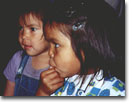INTERGENERATIONAL FACILITATION Intergenerational Facilitator's Role In all partnerships, this position was filled by a member of the partnering First Nations community, who was responsible for seeking out Elders and arranging for them to become involved in the training program. What evaluation data revealed was the pivotal bridging role played by the Intergenerational Facilitators, helping some instructors and students to overcome their initial resistance to the unfamiliar practice of putting indigenous knowledge at the core of curriculum development.
The circle has been broken for so long, our ancestral traditions have been put aside for so long, that the students need time, especially in the beginning. Time to recover who they are. Time to see that they are being asked and being given an opportunity to inherit all the accumulated wisdom of all the generations of people in our Nation who have gone before them. Time to grow into being the leaders in our community that they will become.
|
|
| The program evaluation underscored the importance to students and instructors of being able to discuss Elders' contributions with the Intergenerational Facilitator and to seek advice on cultural protocol for meeting with Elders. As well, the individuals who were most effective in bridging gaps across generations found ways to help students to tolerate ambiguities in the Elders' often indirect teaching through story telling. A stable and strong identity and positive self-esteem are important foundations for effectively socializing children and youth. In our evaluation, we saw more clearly how the involvement of Elders, with the support of the Intergenerational Facilitators, brought all students, even the most disenchanted, into a circle of belonging to a nurturing community. There are as yet few road maps that provide direction on how to orient Elders to community-based programs in education and training, and how to prepare instructors and students to open their hearts and minds to the teachings of Elders. Based on program evaluation findings, we are convinced that the functions played by Intergenerational Facilitators in the partnerships provide one effective approach for other community-inclusive training initiatives that seek to bridge the gap between the worlds of mainstream educators and indigenous communities. |

